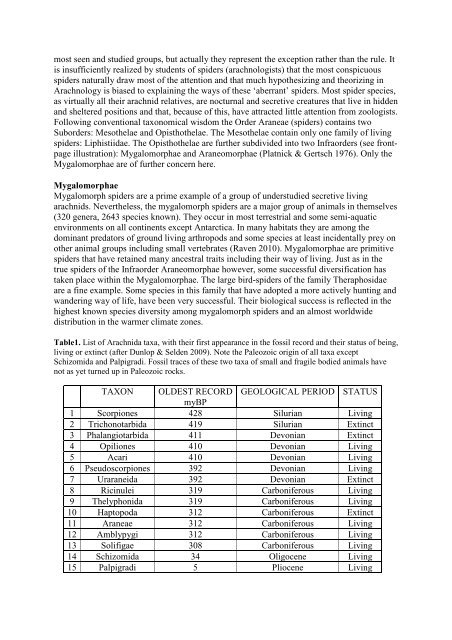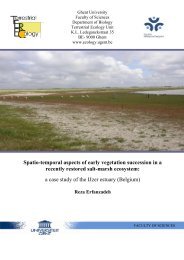PhD Arthur Decae 2010 - Ghent Ecology - Universiteit Gent
PhD Arthur Decae 2010 - Ghent Ecology - Universiteit Gent
PhD Arthur Decae 2010 - Ghent Ecology - Universiteit Gent
Create successful ePaper yourself
Turn your PDF publications into a flip-book with our unique Google optimized e-Paper software.
most seen and studied groups, but actually they represent the exception rather than the rule. It<br />
is insufficiently realized by students of spiders (arachnologists) that the most conspicuous<br />
spiders naturally draw most of the attention and that much hypothesizing and theorizing in<br />
Arachnology is biased to explaining the ways of these ‘aberrant’ spiders. Most spider species,<br />
as virtually all their arachnid relatives, are nocturnal and secretive creatures that live in hidden<br />
and sheltered positions and that, because of this, have attracted little attention from zoologists.<br />
Following conventional taxonomical wisdom the Order Araneae (spiders) contains two<br />
Suborders: Mesothelae and Opisthothelae. The Mesothelae contain only one family of living<br />
spiders: Liphistiidae. The Opisthothelae are further subdivided into two Infraorders (see frontpage<br />
illustration): Mygalomorphae and Araneomorphae (Platnick & Gertsch 1976). Only the<br />
Mygalomorphae are of further concern here.<br />
Mygalomorphae<br />
Mygalomorph spiders are a prime example of a group of understudied secretive living<br />
arachnids. Nevertheless, the mygalomorph spiders are a major group of animals in themselves<br />
(320 genera, 2643 species known). They occur in most terrestrial and some semi-aquatic<br />
environments on all continents except Antarctica. In many habitats they are among the<br />
dominant predators of ground living arthropods and some species at least incidentally prey on<br />
other animal groups including small vertebrates (Raven <strong>2010</strong>). Mygalomorphae are primitive<br />
spiders that have retained many ancestral traits including their way of living. Just as in the<br />
true spiders of the Infraorder Araneomorphae however, some successful diversification has<br />
taken place within the Mygalomorphae. The large bird-spiders of the family Theraphosidae<br />
are a fine example. Some species in this family that have adopted a more actively hunting and<br />
wandering way of life, have been very successful. Their biological success is reflected in the<br />
highest known species diversity among mygalomorph spiders and an almost worldwide<br />
distribution in the warmer climate zones.<br />
Table1. List of Arachnida taxa, with their first appearance in the fossil record and their status of being,<br />
living or extinct (after Dunlop & Selden 2009). Note the Paleozoic origin of all taxa except<br />
Schizomida and Palpigradi. Fossil traces of these two taxa of small and fragile bodied animals have<br />
not as yet turned up in Paleozoic rocks.<br />
TAXON OLDEST RECORD GEOLOGICAL PERIOD STATUS<br />
myBP<br />
1 Scorpiones 428 Silurian Living<br />
2 Trichonotarbida 419 Silurian Extinct<br />
3 Phalangiotarbida 411 Devonian Extinct<br />
4 Opiliones 410 Devonian Living<br />
5 Acari 410 Devonian Living<br />
6 Pseudoscorpiones 392 Devonian Living<br />
7 Uraraneida 392 Devonian Extinct<br />
8 Ricinulei 319 Carboniferous Living<br />
9 Thelyphonida 319 Carboniferous Living<br />
10 Haptopoda 312 Carboniferous Extinct<br />
11 Araneae 312 Carboniferous Living<br />
12 Amblypygi 312 Carboniferous Living<br />
13 Solifigae 308 Carboniferous Living<br />
14 Schizomida 34 Oligocene Living<br />
15 Palpigradi 5 Pliocene Living










